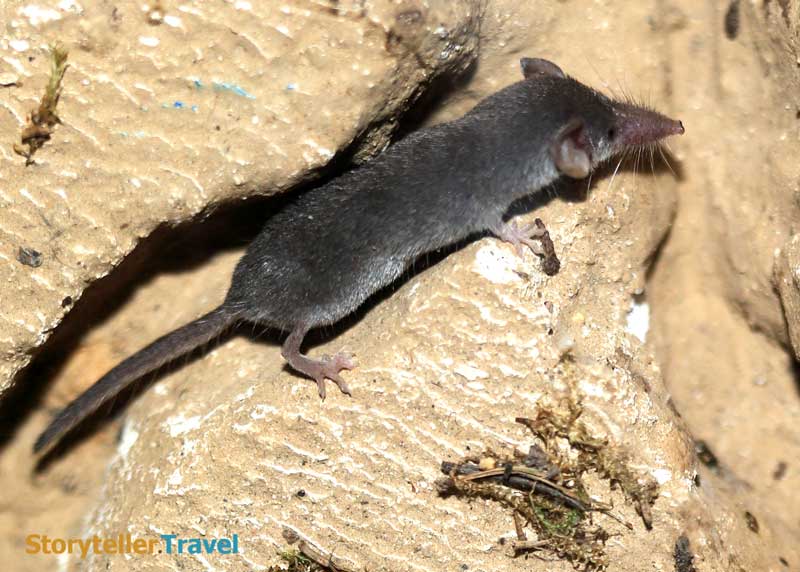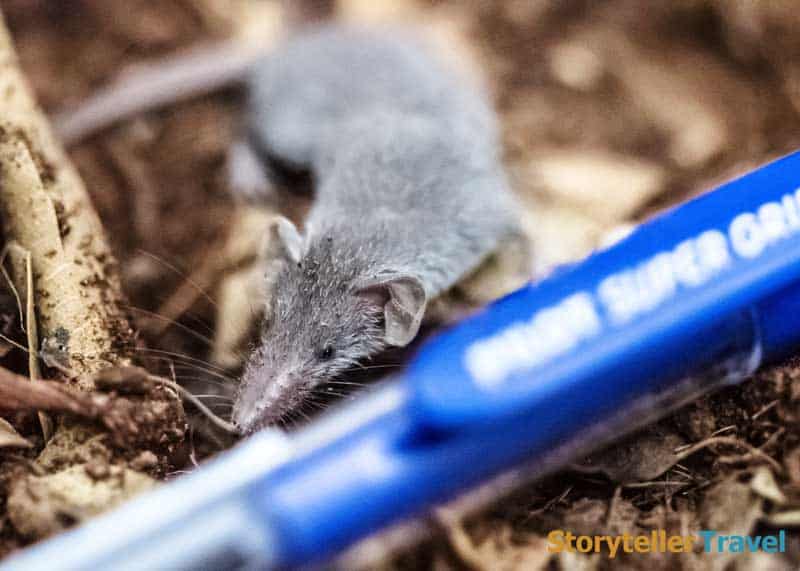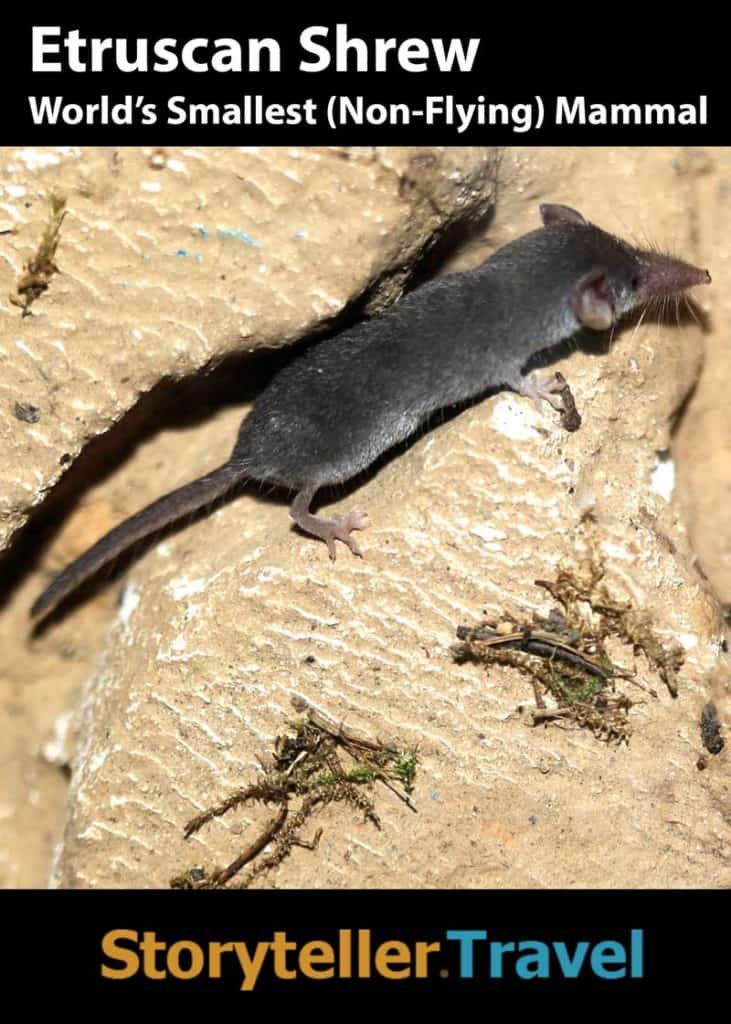14 Etruscan Shrew Facts: World’s Smallest Mammal (Non-Flying)
The Etruscan shrew is an incredible little mammal. It is the smallest mammal in the world, aside from a tiny bat. What do we know about this jittery creature? How small are Etruscan shrews? Are they venomous? If you ever get the chance to see one run past, you may think that it had started its day with 5 cups of coffee!

Etruscan Shrew Overview
- Latin Name: Suncus etruscus
- Location: Southern Europe, Northern Africa, and Southern Asia
- Habitat: Warm and damp rock crevices, vacated burrows, and under shrubs
- Population Status: Least Concern
- Weight: 0.063 ounces (1.8 grams)
- Lenght: 1.6 inches (4 centimeters) plus tail
- Diet: Insects, larvae, earthworms as well as the young of amphibians, lizards, and rodents
- Physical Features: Light brown and gray fur, long snout, slender body, tail
- Lifespan: 2 years
1. What is the scientific classification of the Etruscan shrew?
- Kingdom: Anamalia
- Phylum: Chordata
- Class: Mammalia
- Order: Eulipotyphia
- Family: Soricidae
- Genus: Suncus
- Species: Suncus etruscus
2. Do they go by other names?
The Etruscan shrew is also known as the Etruscan pygmy shrew, and the white-toothed pygmy shrew.
3. Are shrews rodents?
No, despite appearances, shrews are not rodents (like mice, rats, hamsters, etc.). In fact, they are more closely related to animals like hedgehogs and moles.
One difference is in their teeth. Rodents have front incisor teeth used for gnawing, whereas shrews have sharp, spike-like teeth.
4. What does an Etruscan shrew look like?
These cute little mammals have pale brown fur over most of their bodies, with light gray fur on the stomach.
They have relatively large heads, biggish ears, black beady eyes, short whiskers, and a large proboscis (snout). Their bodies are slender, with long tails.
Etruscan shrews also have a mouthful of teeth (usually 30).
Here’s a glimpse of what the Etruscan shrew looks like. Enjoy this video shot near Madrid, Spain.
5. Is the Etruscan shrew the smallest mammal?
Yes, if you are measuring by weight, the Etruscan shrew is the smallest living mammal.
If the parameter you are using is body length, the bumblebee bat (or Kitti’s hog-nosed bat) would be considered the smallest. The bumblebee bat (Craseonycteris thonglongyai) has a head to body length of 1.14 to 1.29 inches (29-33mm).

6. Just how small is the Etruscan shrew?
This shrew is tiny, weighing in at 0.063 ounces (1.8 grams) on average. Its body length (not including the tail) is about 1.6 inches (4 centimeters).
For comparison, other items that have the same approximate weight as the Etruscan shrew include: an American dime, a bottle cap, or a plastic disposable spoon.
7. Where in the world do Etruscan shrews live?
Etruscan shrews prefer living in warm and damp climates.
Most are located between 10° and 30° latitude in the northern hemisphere, in Southern Europe, Northern Africa, and parts of Southern Asia.
8. What is the habitat of the Etruscan shrew?
Etruscan shrews aren’t very good at digging, so they like making their nests in natural shelters like rock crevices.
If another animal has vacated their burrow, an Etruscan shrew will take advantage of the situation and move itself in.
You can also find them under shrubs, as they provide both a damp environment and a place to hide from predators.
9. What does an Etruscan shrew eat?
Because they have a very high metabolism, Etruscan shrews have a ferocious appetite. Each day they eat 1.5-2 times their own weight!
They feed mostly on insects and can take down prey equal to their own size. Grasshoppers are their favorite.
Earthworms and larvae are also on the menu. Sometimes they will feed on young lizards, amphibians, and rodents. They sure are hungry little things.
10. What is the heart rate of an Etruscan shrew?
Shrews are jittery and almost always moving. Their heart rate reflects this level of activity, beating at up to 1511 beats a minute. That works out to be about 25 beats a second.
A human heart, by comparison, beats around 60-100 times a minute (while at rest).
11. What are baby shrews called?
Baby shrews are called cubs. There are usually 2-6 cubs per litter. Etruscan shrews are born blind and naked.
If mama shrew has to relocate the babies, they will form a train, with each cub biting the tail of the cub in front of them.
12. Are shrews poisonous?
Some species of shrews are venomous, but the Etruscan shrew is not one of them.
The following species of shrews are venomous:
- Northern Short-Tailed Shrew (Blarina brevicauda)
- Mediterranean Water Shrew (Neomys anomalus)
- Eurasian Water Shrew (Neomys fodiens)
The following species of shrews may be venomous:
- Southern Short-Tailed Shrew (Blarina carolinensis)
- Elliot’s Short-Tailed Shrew (Blarina hylophaga)
- Everglade’s Short-Tailed Shrew (Blarina peninsulae)
- Transcaucasian Water Shrew (Neomys teres)
13. Are Etruscan shrews endangered?
No, they are not endangered. They do have predators like birds of prey, and unhappy farmers. They also are sensitive to changes in the climate such as extreme cold or periods of drought.
Despite that, the Etruscan shrew population is quite healthy, and listed as Least Concern (IUCN).
14. How long does an Etruscan shrew live?
The Etruscan shrew is estimated to live up to 2 years.
You can find Etruscan shrews in northern Africa. Learn more about the highest mountains in Africa.

Like small critters? Check out this post about rhino beetles.
Your Turn:
What was your favorite fact about the Etruscan shrew? Do you have something to add to my list? Please share your thought in the comments below.







this is cool I wrote an essay on this shrew.